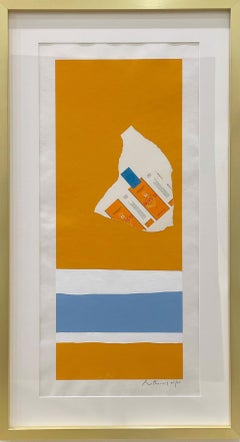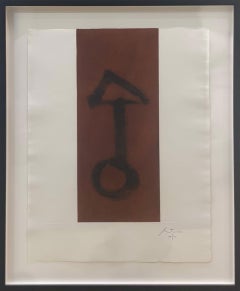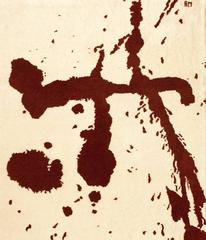Robert Motherwell More Art
The name of painter, printmaker and writer Robert Motherwell (1915–91) is often taken as synonymous with the New York School, whose name he coined. Motherwell was the youngest of this group of Abstract Expressionists working in art, dance, poetry and music in 1950s and '60s New York City, which included Jackson Pollock, Willem de Kooning, Philip Guston, Helen Frankenthaler and Mark Rothko.
Born in Aberdeen, Washington, in 1915, Motherwell had perhaps the broadest and best education of any of the New York School coterie, with an extensive background in philosophy, literature and art history. He earned a BA in philosophy in 1937 from Stanford University and was working toward a PhD in the subject at Harvard when he interrupted his studies for a yearlong trip to Europe, where he fell in love with European modernism.
After returning, in 1940 he enrolled Columbia to study art history. It was there that he met a group of exiled Parisian Surrealists, and encounter that proved influential on his style. Motherwell began to integrate the idea of “automatism” — unmediated gestures that reflect deeper psychological impulses — into his work, pioneering a new form of Abstract Expressionism that came to characterize the New York School.
Works like the 1967 Beside the Sea no. 45, an acrylic on canvas, and the 1966 lithograph New York International epitomize Motherwell’s use of simple shapes in boldly contrasting colors, executed in quick, gestural strokes that occasionally evoke figures, suggesting a latent narrative despite their obvious abstraction.
Throughout his career, Motherwell taught painting at Hunter College, in New York, and at Black Mountain College, in North Carolina, where his work influenced the likes of Cy Twombly, Robert Rauschenberg and Kenneth Noland. His influence as one of the founding fathers of American Abstract Expressionism remains profound.
21st Century and Contemporary Robert Motherwell More Art
Paper
1970s Abstract Expressionist Robert Motherwell More Art
Screen, Color
21st Century and Contemporary Robert Motherwell More Art
Paint
1970s Abstract Expressionist Robert Motherwell More Art
Screen, Color
17th Century Baroque Robert Motherwell More Art
Chalk, Handmade Paper
1990s Abstract Expressionist Robert Motherwell More Art
Screen
1690s Baroque Robert Motherwell More Art
Oil, Canvas
1950s Abstract Expressionist Robert Motherwell More Art
Screen
1950s Abstract Geometric Robert Motherwell More Art
Oil
Juliette SteeleGeometric Abstraction Oil Painting on Masonite by Juliette Steele, Framed, circe 1950
1980s Abstract Expressionist Robert Motherwell More Art
Screen
1960s Abstract Expressionist Robert Motherwell More Art
Screen
2010s Abstract Expressionist Robert Motherwell More Art
Porcelain, Screen, Cardboard, Mixed Media
1970s Abstract Expressionist Robert Motherwell More Art
Screen
1970s Abstract Expressionist Robert Motherwell More Art
Screen
Mid-20th Century Abstract Expressionist Robert Motherwell More Art
Screen
1990s Abstract Expressionist Robert Motherwell More Art
Porcelain, Mixed Media, Screen
1960s Abstract Expressionist Robert Motherwell More Art
1960s Robert Motherwell More Art
Wool
Robert Motherwell more art for sale on 1stDibs.
Artists Similar to Robert Motherwell
- 1stDibs ExpertAugust 29, 2024No, Robert Motherwell was not a Surrealist painter. The American artist was the youngest member of the New York School, a group of Abstract Expressionists working in art, dance, poetry and music in the 1950s and '60s. However, Motherwell did meet a group of exiled Parisian Surrealists while attending Columbia University to study art history in the 1940s. This encounter proved influential in his style. Inspired by their work, Motherwell began to integrate the idea of “automatism," unmediated gestures that reflect deeper psychological impulses, into his work, pioneering a new form of Abstract Expressionism that came to characterize the New York School. On 1stDibs, find a selection of Robert Motherwell art.
- 1stDibs ExpertApril 5, 2022Robert Motherwell was a part of the art movement called Abstract Expressionism. Artists who participated in the movement sought to express emotions through abstract forms. You'll find a range of Robert Motherwell art from some of the world’s top sellers on 1stDibs.




